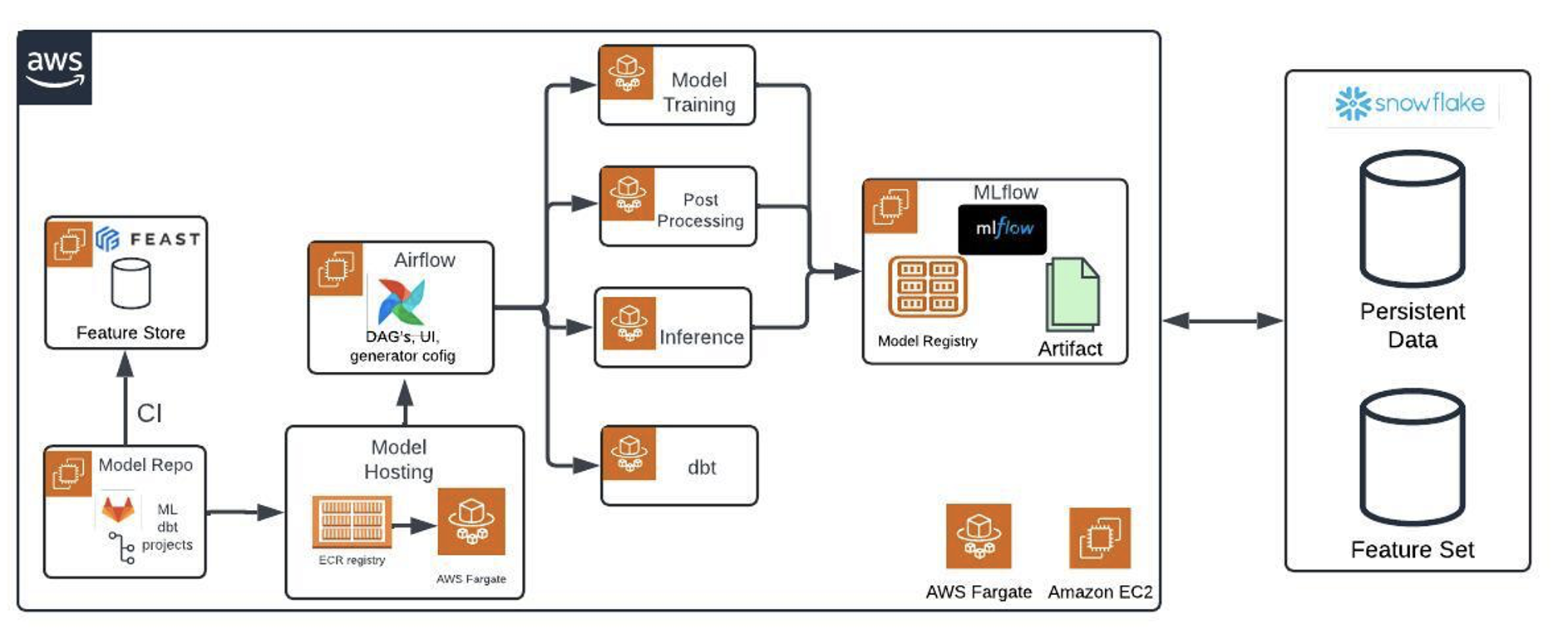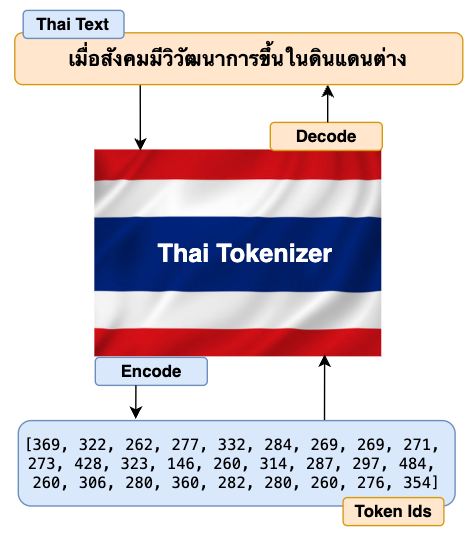
Originally appeared here:
Reinvent personalization with generative AI on Amazon Bedrock using task decomposition for agentic workflows


Originally appeared here:
Reinvent personalization with generative AI on Amazon Bedrock using task decomposition for agentic workflows


Originally appeared here:
Accelerate pre-training of Mistral’s Mathstral model with highly resilient clusters on Amazon SageMaker HyperPod


Originally appeared here:
Building an efficient MLOps platform with OSS tools on Amazon ECS with AWS Fargate



The primary task of the Tokenizer is to translate the raw input texts (Thai in our case but can be in any foreign language) into numbers and pass them to the model’s transformers. The model’s transformer then generates output as numbers. Again, Tokenizer translates these numbers back to texts which is understandable to end users. The high level diagram below describes the flow explained above.

Generally, many of us are only interested in learning how the model’s transformer architecture works under the hood. We often overlook learning some important components such as tokenizers in detail. Understanding how tokenizer works under the hood and having good control of its functionalities gives us good leverage to improve our model’s accuracy and performance.
Similar to Tokenizer, some of the most important components of LLM implementation pipelines are Data preprocessing, Evaluation, Guardrails/Security, and Testing/Monitoring. I would highly recommend you study more details on these topics. I realized the importance of these components only after I was working on the actual implementation of my foundational multilingual model ThaiLLM in production.
The good news is that after you finish building Thai Tokenizer, you can easily build a tokenizer in any other language. All the building steps are the same except that you’ll have to train on the dataset of your choice of language.
Now that we’ve all the good reason to build our own tokenizer. Below are steps to building our tokenizer in the Thai language.
The BPE algorithm is used in many popular LLMs such as Llama, GPT, and others to build their tokenizer. We can choose one of these LLM tokenizers if our model is based on the English language. Since we’re building the Thai Tokenizer, the best option is to create our own BPE algorithm from scratch and use it to build our tokenizer. Let’s first understand how the BPE algorithm works with the help of the simple flow diagram below and then we’ll start building it accordingly.

The examples in the flow diagram are shown in English to make it easier to understand.
Let’s write code to implement the BPE algorithm for our Thai Tokenizer.
# A simple practice example to get familiarization with utf-8 encoding to convert strings to bytes.
text = "How are you คุณเป็นอย่างไร" # Text string in both English and Thai
text_bytes = text.encode("utf-8")
print(f"Text in byte: {text_bytes}")
text_list = list(text_bytes) # Converts text bytes to a list of integer
print(f"Text list in integer: {text_list}")
# As I don't want to reinvent the wheel, I will be referencing most of the code block from Andrej Karpathy's GitHub (https://github.com/karpathy/minbpe?tab=readme-ov-file).
# However, I'll be modifying code blocks specific to building our Thai language tokenizer and also explaining the codes so that you can understand how each code block works and make it easy when you implement code for your use case later.
# This module provides access to the Unicode Character Database (UCD) which defines character properties for all Unicode characters.
import unicodedata
# This function returns a dictionary with consecutive pairs of integers and their counts in the given list of integers.
def get_stats(ids, stats=None):
stats = {} if stats is None else stats
# zip function allows to iterate consecutive items from given two list
for pair in zip(ids, ids[1:]):
# If a pair already exists in the stats dictionary, add 1 to its value else assign the value as 0.
stats[pair] = stats.get(pair, 0) + 1
return stats
# Once we find out the list of consecutive pairs of integers, we'll then replace those pairs with new integer tokens.
def merge(ids, pair, idx):
newids = []
i = 0
# As we'll be merging a pair of ids, hence the minimum id in the list should be 2 or more.
while i < len(ids):
# If the current id and next id(id+1) exist in the given pair, and the position of id is not the last, then replace the 2 consecutive id with the given index value.
if ids[i] == pair[0] and i < len(ids) - 1 and ids[i+1] == pair[1]:
newids.append(idx)
i += 2 # If the pair is matched, the next iteration starts after 2 positions in the list.
else:
newids.append(ids[i])
i += 1 # Since the current id pair didn't match, so start iteration from the 1 position next in the list.
# Returns the Merged Ids list
return newids
# This function checks that using 'unicodedata.category' which returns "C" as the first letter if it is a control character and we'll have to replace it readable character.
def replace_control_characters(s: str) -> str:
chars = []
for ch in s:
# If the character is not distorted (meaning the first letter doesn't start with "C"), then append the character to chars list.
if unicodedata.category(ch)[0] != "C":
chars.append(ch)
# If the character is distorted (meaning the first letter has the letter "C"), then replace it with readable bytes and append to chars list.
else:
chars.append(f"\u{ord(ch):04x}")
return "".join(chars)
# Some of the tokens such as control characters like Escape Characters can't be decoded into valid strings.
# Hence those need to be replace with readable character such as �
def render_token(t: bytes) -> str:
s = t.decode('utf-8', errors='replace')
s = replace_control_characters(s)
return s
The two functions get_stats and merge defined above in the code block are the implementation of the BPE algorithm for our Thai Tokenizer. Now that the algorithm is ready. Let’s write code to train our tokenizer.
Training tokenizer involves generating a vocabulary which is a database of unique tokens (word and sub-words) along with a unique index number assigned to each token. We’ll be using the Thai Wiki dataset from the Hugging Face to train our Thai Tokenizer. Just like training an LLM requires a huge data, you’ll also require a good amount of data to train a tokenizer. You could also use the same dataset to train the LLM as well as tokenizer though not mandatory. For a multilingual LLM, it is advisable to use both the English and Thai datasets in the ratio of 2:1 which is a standard approach many practitioners follow.
Let’s begin writing the training code.
# Import Regular Expression
import regex as re
# Create a Thai Tokenizer class.
class ThaiTokenizer():
def __init__(self):
# The byte pair should be done within the related words or sentences that give a proper context. Pairing between unrelated words or sentences may give undesirable output.
# To prevent this behavior, we'll implement the LLama 3 regular expression pattern to make meaningful chunks of our text before implementing the byte pair algorithm.
self.pattern = r"(?i:'s|'t|'re|'ve|'m|'ll|'d)|[^rnp{L}p{N}]?p{L}+|p{N}{1,3}| ?[^sp{L}p{N}]+[rn]*|s*[rn]+|s+(?!S)|s+"
self.compiled_pattern = re.compile(self.pattern)
# Special tokens are used to provide coherence in the sequence while training.
# Special tokens are assigned a unique index number and stored in vocabulary.
self.special_tokens = {
'<|begin_of_text|>': 1101,
'<|end_of_text|>': 1102,
'<|start_header_id|>': 1103,
'<|end_header_id|>': 1104,
'<|eot_id|>': 1105
}
# Initialize merges with empty dictionary
self.merges = {}
# Initialize the vocab dictionary by calling the function _build_vocab which is defined later in this class.
self.vocab = self._build_vocab()
# Tokenizer training function
def train(self, text, vocab_size):
# Make sure the vocab size must be at least 256 as the utf-8 encoding for the range 0-255 are same as the Ascii character.
assert vocab_size >= 256
# Total number of merges into the vocabulary.
num_merges = vocab_size - 256
# The first step is to make sure to split the text up into text chunks using the pattern defined above.
text_chunks = re.findall(self.compiled_pattern, text)
# Each text_chunks will be utf-8 encoded to bytes and then converted into an integer list.
ids = [list(ch.encode("utf-8")) for ch in text_chunks]
# Iteratively merge the most common pairs to create new tokens
merges = {} # (int, int) -> int
vocab = {idx: bytes([idx]) for idx in range(256)} # idx -> bytes
# Until the total num_merges is reached, find the common pair of consecutive id in the ids list and start merging them to create a new token
for i in range(num_merges):
# Count the number of times every consecutive pair appears
stats = {}
for chunk_ids in ids:
# Passing in stats will update it in place, adding up counts
get_stats(chunk_ids, stats)
# Find the pair with the highest count
pair = max(stats, key=stats.get)
# Mint a new token: assign it the next available id
idx = 256 + i
# Replace all occurrences of pair in ids with idx
ids = [merge(chunk_ids, pair, idx) for chunk_ids in ids]
# Save the merge
merges[pair] = idx
vocab[idx] = vocab[pair[0]] + vocab[pair[1]]
# Save class variables to be used later during tokenizer encode and decode
self.merges = merges
self.vocab = vocab
# Function to return a vocab dictionary combines with merges and special tokens
def _build_vocab(self):
# The utf-8 encoding for the range 0-255 are same as the Ascii character.
vocab = {idx: bytes([idx]) for idx in range(256)}
# Iterate through merge dictionary and add into vocab dictionary
for (p0, p1), idx in self.merges.items():
vocab[idx] = vocab[p0] + vocab[p1]
# Iterate through special token dictionary and add into vocab dictionary
for special, idx in self.special_tokens.items():
vocab[idx] = special.encode("utf-8")
return vocab
# After training is complete, use the save function to save the model file and vocab file.
# Model file will be used to load the tokenizer model for further use in llm
# Vocab file is just for the purpose of human verification
def save(self, file_prefix):
# Writing to model file
model_file = file_prefix + ".model" # model file name
# Model write begins
with open(model_file, 'w') as f:
f.write("thai tokenizer v1.0n") # write the tokenizer version
f.write(f"{self.pattern}n") # write the pattern used in tokenizer
f.write(f"{len(self.special_tokens)}n") # write the length of special tokens
# Write each special token in the specific format like below
for tokens, idx in self.special_tokens.items():
f.write(f"{tokens} {idx}n")
# Write only the keys part from the merges dict
for idx1, idx2 in self.merges:
f.write(f"{idx1} {idx2}n")
# Writing to the vocab file
vocab_file = file_prefix + ".vocab" # vocab file name
# Change the position of keys and values of merge dict and store into inverted_merges
inverted_merges = {idx: pair for pair, idx in self.merges.items()}
# Vocab write begins
with open(vocab_file, "w", encoding="utf-8") as f:
for idx, token in self.vocab.items():
# render_token function processes tokens and prevents distorted bytes by replacing them with readable character
s = render_token(token)
# If the index of vocab is present in merge dict, then find its child index, convert their corresponding bytes in vocab dict and write the characters
if idx in inverted_merges:
idx0, idx1 = inverted_merges[idx]
s0 = render_token(self.vocab[idx0])
s1 = render_token(self.vocab[idx1])
f.write(f"[{s0}][{s1}] -> [{s}] {idx}n")
# If index of vocab is not present in merge dict, just write it's index and the corresponding string
else:
f.write(f"[{s}] {idx}n")
# Function to load tokenizer model.
# This function is invoked only after the training is complete and the tokenizer model file is saved.
def load(self, model_file):
merges = {} # Initialize merge and special_tokens with empty dict
special_tokens = {} # Initialize special_tokens with empty dict
idx = 256 # As the range (0, 255) is already reserved in vocab. So the next index only starts from 256 and onwards.
# Read model file
with open(model_file, 'r', encoding="utf-8") as f:
version = f.readline().strip() # Read the tokenizer version as defined during model file writing
self.pattern = f.readline().strip() # Read the pattern used in tokenizer
num_special = int(f.readline().strip()) # Read the length of special tokens
# Read all the special tokens and store in special_tokens dict defined earlier
for _ in range(num_special):
special, special_idx = f.readline().strip().split()
special_tokens[special] = int(special_idx)
# Read all the merge indexes from the file. Make it a key pair and store it in merge dictionary defined earlier.
# The value of this key pair would be idx(256) as defined above and keep on increase by 1.
for line in f:
idx1, idx2 = map(int, line.split())
merges[(idx1, idx2)] = idx
idx += 1
self.merges = merges
self.special_tokens = special_tokens
# Create a final vocabulary dictionary by combining merge, special_token and vocab (0-255). _build_vocab function helps to do just that.
self.vocab = self._build_vocab()
Let’s take a look at the diagram below to have further clarity.

Let’s write code to implement the tokenizer’s encode and decode function.
# Tokenizer encode function takes text as a string and returns integer ids list
def encode(self, text):
# Define a pattern to identify special token present in the text
special_pattern = "(" + "|".join(re.escape(k) for k in self.special_tokens) + ")"
# Split special token (if present) from the rest of the text
special_chunks = re.split(special_pattern, text)
# Initialize empty ids list
ids = []
# Loop through each of parts in the special chunks list.
for part in special_chunks:
# If the part of the text is the special token, get the idx of the part from the special token dictionary and append it to the ids list.
if part in self.special_tokens:
ids.append(self.special_tokens[part])
# If the part of text is not a special token
else:
# Split the text into multiple chunks using the pattern we've defined earlier.
text_chunks = re.findall(self.compiled_pattern, text)
# All text chunks are encoded separately, then the results are joined
for chunk in text_chunks:
chunk_bytes = chunk.encode("utf-8") # Encode text to bytes
chunk_ids = list(chunk_bytes) # Convert bytes to list of integer
while len(chunk_ids) >= 2: # chunks ids list must be at least 2 id to form a byte-pair
# Count the number of times every consecutive pair appears
stats = get_stats(chunk_ids)
# Some idx pair might be created with another idx in the merge dictionary. Hence we'll find the pair with the lowest merge index to ensure we cover all byte pairs in the merge dict.
pair = min(stats, key=lambda p: self.merges.get(p, float("inf")))
# Break the loop and return if the pair is not present in the merges dictionary
if pair not in self.merges:
break
# Find the idx of the pair present in the merges dictionary
idx = self.merges[pair]
# Replace the occurrences of pair in ids list with this idx and continue
chunk_ids = merge(chunk_ids, pair, idx)
ids.extend(chunk_ids)
return ids
# Tokenizer decode function takes a list of integer ids and return strings
def decode(self, ids):
# Initialize empty byte list
part_bytes = []
# Change the position of keys and values of special_tokens dict and store into inverse_special_tokens
inverse_special_tokens = {v: k for k, v in self.special_tokens.items()}
# Loop through idx in the ids list
for idx in ids:
# If the idx is found in vocab dict, get the bytes of idx and append them into part_bytes list
if idx in self.vocab:
part_bytes.append(self.vocab[idx])
# If the idx is found in inverse_special_tokens dict, get the token string of the corresponding idx, convert it to bytes using utf-8 encode and then append it into part_bytes list
elif idx in inverse_special_tokens:
part_bytes.append(inverse_special_tokens[idx].encode("utf-8"))
# If the idx is not found in both vocab and special token dict, throw an invalid error
else:
raise ValueError(f"invalid token id: {idx}")
# Join all the individual bytes from the part_byte list
text_bytes = b"".join(part_bytes)
# Convert the bytes to text string using utf-8 decode function. Make sure to use "errors=replace" to replace distorted characters with readable characters such as �.
text = text_bytes.decode("utf-8", errors="replace")
return text
Finally, here comes the best part of this article. In this section, we’ll perform two interesting tasks.
Let’s dive in.
# Train the tokenizer
import time # To caculate the duration of training completion
# Load training raw text data (thai_wiki dataset) from huggingface. thai_wiki_small.text: https://github.com/tamangmilan/thai_tokenizer
texts = open("/content/thai_wiki_small.txt", "r", encoding="utf-8").read()
texts = texts.strip()
# Define vocab size
vocab_size = 512
# Initialize a tokenizer model class
tokenizer = ThaiTokenizer()
# Start train a tokenizer
start_time = time.time()
tokenizer.train(texts, vocab_size)
end_time = time.time()
# Save tokenizer: you can change path and filename.
tokenizer.save("./models/thaitokenizer")
print(f"Total time to complete tokenizer training: {end_time-start_time:.2f} seconds")
# Output: Total time to complete tokenizer training: 186.11 seconds (3m 6s) [Note: Training duration will be longer if vocab_size is bigger and lesser for smaller vocab_size]
# Test the tokenizer
# Initialize a tokenizer model class
tokenizer = ThaiTokenizer()
# Load tokenizer model. This model was saved during training.
tokenizer.load("./models/thaitokenizer.model")
# Invoke and verify the tokenizer encode and decode function for English Language
eng_texts = "When society evolved in different lands"
print(f"English Text: {eng_texts}")
encoded_ids = tokenizer.encode(eng_texts)
print(f"Encoded Ids: {encoded_ids}")
decoded_texts = tokenizer.decode(encoded_ids)
print(f"Decoded Texts: {decoded_texts}n")
# Invoke and verify the tokenizer encode and decode function for Thai Language
thai_texts = "เมื่อสังคมมีวิวัฒนาการขึ้นในดินแดนต่าง"
print(f"Thai Text: {thai_texts}")
thai_encoded_ids = tokenizer.encode(thai_texts)
print(f"Encoded Ids: {thai_encoded_ids}")
thai_decoded_texts = tokenizer.decode(thai_encoded_ids)
print(f"Decoded Texts: {thai_decoded_texts}")

Perfect. Our Thai Tokenizer can now successfully and accurately encode and decode texts in both Thai and English languages.
Have you noticed that the encoded IDs for English texts are longer than Thai encoded IDs? This is because we’ve only trained our tokenizer with the Thai dataset. Hence the tokenizer is only able to build a comprehensive vocabulary for the Thai language. Since we didn’t train with an English dataset, the tokenizer has to encode right from the character level which results in longer encoded IDs. As I have mentioned before, for multilingual LLM, you should train both the English and Thai datasets with a ratio of 2:1. This will give you balanced and quality results.
And that is it! We have now successfully created our own Thai Tokenizer from scratch only using Python. And, I think that was pretty cool. With this, you can easily build a tokenizer for any foreign language. This will give you a lot of leverage while implementing your Multilingual LLM.
Thanks a lot for reading!
References
[1] Andrej Karpathy, Git Hub: Karpthy/minbpe
Build a Tokenizer for the Thai Language from Scratch was originally published in Towards Data Science on Medium, where people are continuing the conversation by highlighting and responding to this story.
Originally appeared here:
Build a Tokenizer for the Thai Language from Scratch
Go Here to Read this Fast! Build a Tokenizer for the Thai Language from Scratch


Dimensionality reduction through Principal Component Analysis (PCA).
Originally appeared here:
Principal Component Analysis — Hands-On Tutorial
Go Here to Read this Fast! Principal Component Analysis — Hands-On Tutorial

Markov Decision Processes are foundational to sequential decision-making problems and serve as the building block for reinforcement learning. They model the dynamic interaction between an agent having to make a series of actions and their environment. Due to their wide applicability in fields such as robotics, finance, operations research and AI, MDPs have been extensively studied in both theoretical and practical contexts.
Yet, much of the existing MDP literature focuses on the idealized scenarios where model parameters — such as transition probabilities and reward functions — are assumed to be known with certainty. In practice, applying popular methods such as Policy Iteration and Value Iteration require precise estimates of these parameters, often obtained from real-world data. This reliance on data introduces significant challenges: the estimation process is inherently noisy and sensitive to limitations such as data scarcity, measurement errors and variability in the observed environment. Consequently, the performance of standard MDP methods can degrade substantially when applied to problems with uncertain or incomplete data.
In this article, we build on the Robust Optimization (RO) literature to propose a generic framework to address these issues. We provide a Robust Linear Programming (RLP) formulation of MDPs that is capable of handling various sources of uncertainty and adversarial perturbations.
Let’s start by giving a formal definition of MDPs:
A Markov Decision Process is a 5-tuple (S, A, R, P, γ) such that:
We then define the policy, i.e. what dictates the agent’s behavior in an MDP:
A policy π is a probability measure over the action space defined as: π(a|s) is the probability of taking action a when the agent is in state s.
We finally introduce the value function, i.e. the agent’s objective in an MDP:
The value function of a policy π is the expected discounted reward under this policy, when starting at a given state s:

In particular, the value function of the optimal policy π* satisfies the Bellman optimality equation:

Which yields the deterministic optimal policy:

Given the above definitions, we can start by noticing that any value function V that satisfies

is an upper bound on the optimal value function. To see it, we can start by noticing that such value function also satisfies:

We recognize the value iteration operator applied to V:

i.e.

Also noticing that the H*operator is increasing, we can apply it iteratively to have:

where we used the property of V* being the fixed point of H*.
Therefore, finding V* comes down to finding the tightest upper bound V that obeys the above equation, which yields the following formulation:

Here we added a weight term corresponding to the probability of starting in state s. We can see that the above problem is linear in V and can be rewritten as follows:

Further details can be found in [1] and [2].
Given the above linear program in standard form, the RO framework assumes an adversarial noise in the inputs (i.e. cost vector and constraints). To model this uncertainty, we define an uncertainty set:

In short, we want to find the minimum of all linear programs, i.e. for each occurrence in the uncertainty set. Naturally this yields a completely intractable model (potentially an infinite number of LPs) since we did not make any assumption on the form of U.
Before addressing these issues, we make the following assumptions — without loss of generality:

where: bar{c} is known as the nominal constraint vector (e.g. gotten from some estimation), z the uncertain factor and Q a fixed matrix intuitively corresponding to how the noise is applied to each coefficient of the constraint vector. Q can be used for instance to model correlation between the noise on difference components of c. See [3] for more details and proofs.
Note: we made a slight abuse of notation and dropped the (s, a) subscripts for readability — yet c, bar{c}, Q and z are all for a given state and action couple.
All this leads to the following formulation of the problem:

At this stage, we can make some assumptions on the form of U in order to further simplify the problem:
The optimization problem becomes:

which is equivalent to:

Finally, looking closer to the maximization problem in the constraint, we see that it has a closed form. Therefore the final problem can be written as (robust counterpart of a linear program with box uncertainty):

A few comments on the above formulation:
For more details, the interested reader can refer to [3].
Starting from the above formulation:

And finally, linearizing the absolute value in the constraints gives:

We notice that robustness translates into an additional safety term in the constraints — given the uncertainty on c (which mainly translates into uncertainty in the MDP’s transition probabilities).
As stated previously, considering uncertainty on the rewards as well can be easily done with a similar derivation. Coming back to the linear program in standard form, we add another noise term on the right hand side of the constraints:

After a similar reasoning as previously done, we have the all-in linear program:

Again similarly to before, additional robustness with regards to the reward function translates into another safety term in the constraints, which ultimately can yield a less optimal value function and policy but fills the constraints with margin. This tradeoff is controlled both by Q and the size of the uncertainty box d.
While this completes the derivation of the Robust MDP as a linear program, other robust MDP approaches have been developed in the literature, see for instance [4]. These approaches usually take a different route, for instance directly deriving a robust Policy Evaluation operator — which for instance has the advantage of having a better complexity as the LP approach. This proves particularly important when state and action spaces are large. Therefore why would we use such formulation?
[1] M.L. Puterman, Markov Decision Processes: Discrete Stochastic Dynamic Programming (1996), Wiley
[2] P. Pouppart, Sequential Decision Making and Reinforcement Learning (2013), University of Waterloo
[3] D. Bertsimas, D. Den Hertog, Robust and Adaptive Optimization (2022), Dynamic Ideas
[4] W. Wiesemann, D. Kuhn, B. Rustem, Robust Markov Decision Processes (2013), INFORMS
[5] K. Vu, P.-L. Poirion, L. Liberti, Random Projections for Linear Programming (2018), INFORMS
Uncertainty in Markov Decisions Processes: a Robust Linear Programming approach was originally published in Towards Data Science on Medium, where people are continuing the conversation by highlighting and responding to this story.
Originally appeared here:
Uncertainty in Markov Decisions Processes: a Robust Linear Programming approach



Thread is a new IP-based smart home connectivity standard that has slowly been increasing in adoption in recent years. It’s an alternative to Wi-Fi, Bluetooth, or Zigbee and is incredibly low-power and fast.
It first debuted in the HomePod mini and a few Nanoleaf lights but there are now several smart home products that have utilized it.
Go Here to Read this Fast! Apple enables direct Thread control for smart home devices with iOS 18
Originally appeared here:
Apple enables direct Thread control for smart home devices with iOS 18



Thread is a new IP-based smart home connectivity standard that has slowly been increasing in adoption in recent years. It’s an alternative to Wi-Fi, Bluetooth, or Zigbee and is incredibly low-power and fast.
It first debuted in the HomePod mini and a few Nanoleaf lights but there are now several smart home products that have utilized it.
Go Here to Read this Fast! Apple enables direct Thread control for smart home devices with iOS 18
Originally appeared here:
Apple enables direct Thread control for smart home devices with iOS 18

![]()
Apple’s introduction of App Tracking Transparency (ATT) in 2021 immediately hurt social media income. Ultimately, Meta said that Facebook alone would earn $10 billion less in 2022 than expected, solely because of Apple’s then-new privacy settings in iOS.
Now according to Reuters, a lawsuit was brought against Meta by shareholders over the issue. The suit alleged that Meta had defrauded shareholders by concealing the extent of how ATT would affect advertising.
Go Here to Read this Fast! Judge dismisses suit against Facebook over iOS privacy settings
Originally appeared here:
Judge dismisses suit against Facebook over iOS privacy settings

![]()
Apple’s introduction of App Tracking Transparency (ATT) in 2021 immediately hurt social media income. Ultimately, Meta said that Facebook alone would earn $10 billion less in 2022 than expected, solely because of Apple’s then-new privacy settings in iOS.
Now according to Reuters, a lawsuit was brought against Meta by shareholders over the issue. The suit alleged that Meta had defrauded shareholders by concealing the extent of how ATT would affect advertising.
Go Here to Read this Fast! Judge dismisses suit against Facebook over iOS privacy settings
Originally appeared here:
Judge dismisses suit against Facebook over iOS privacy settings